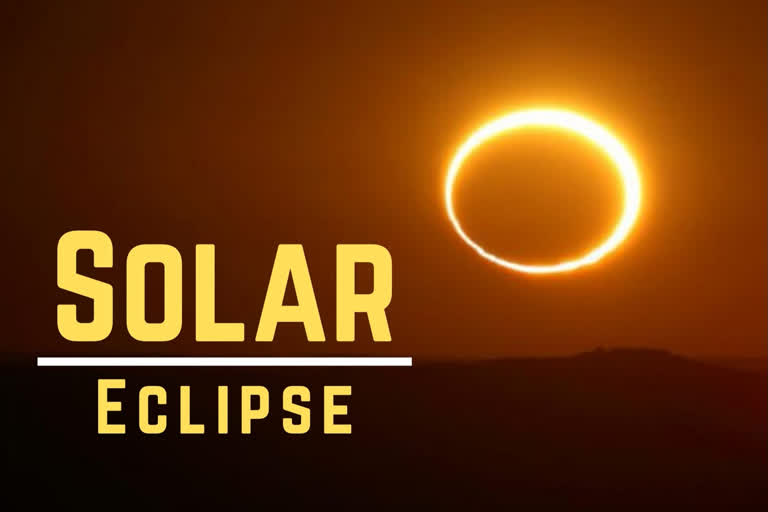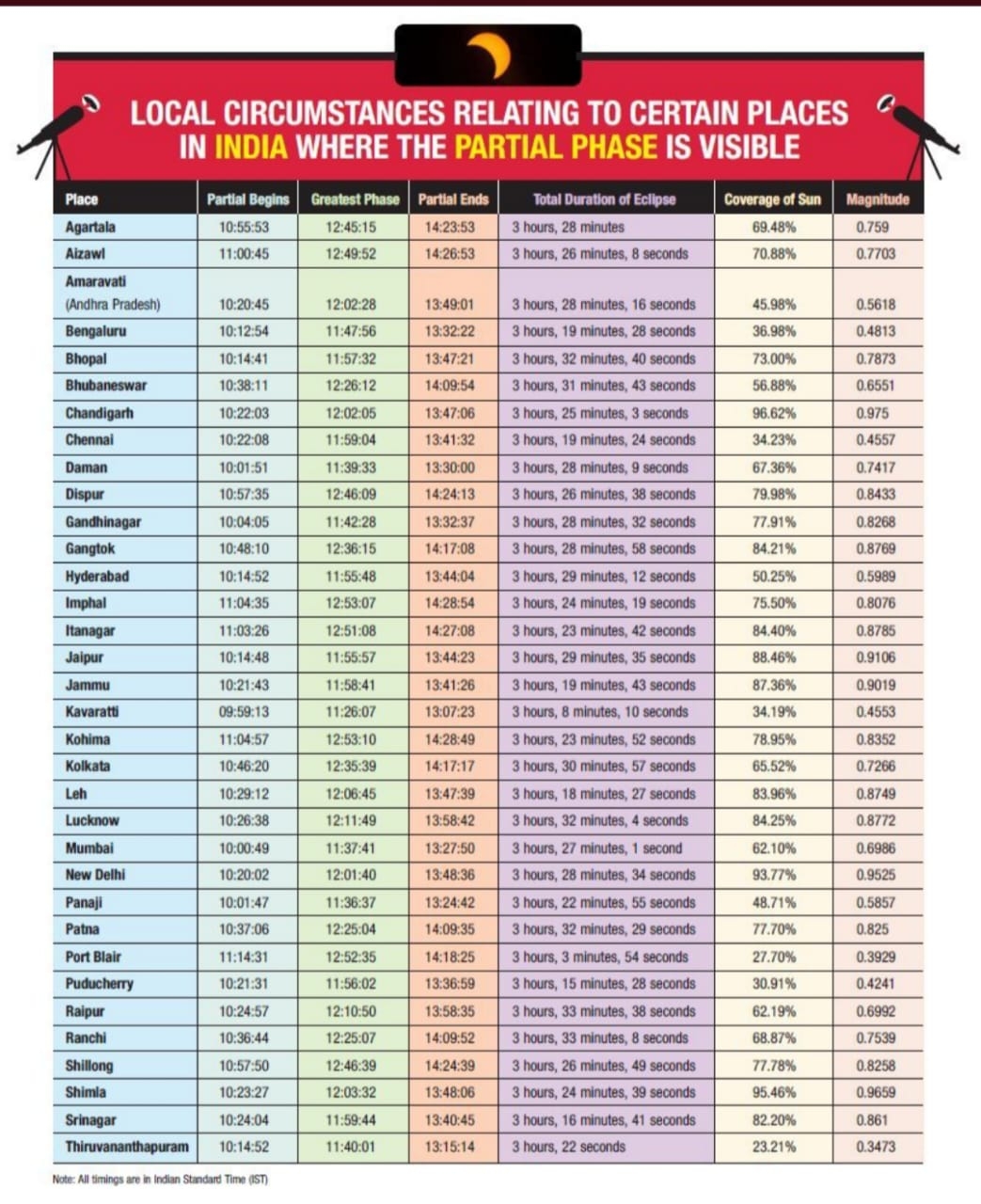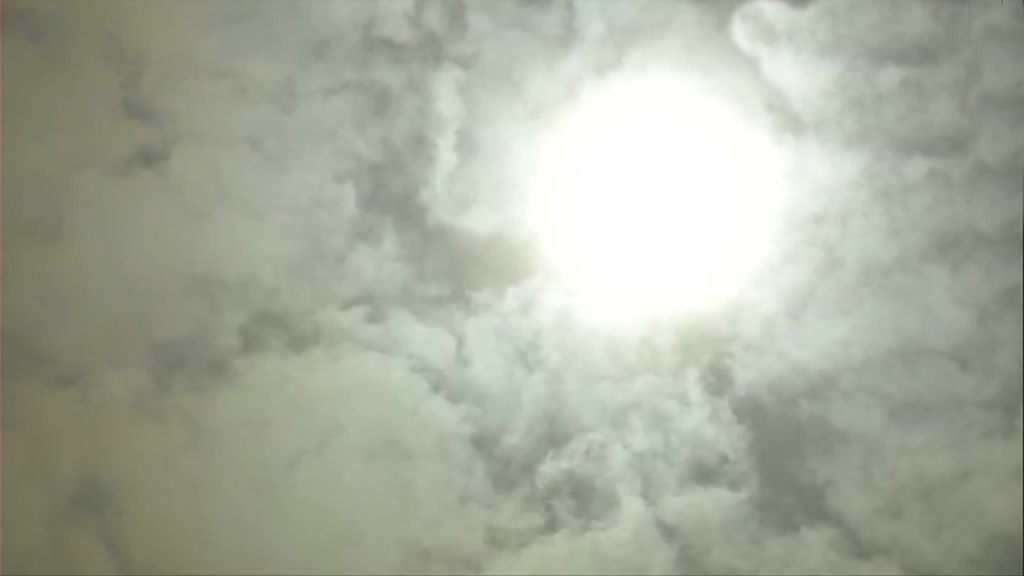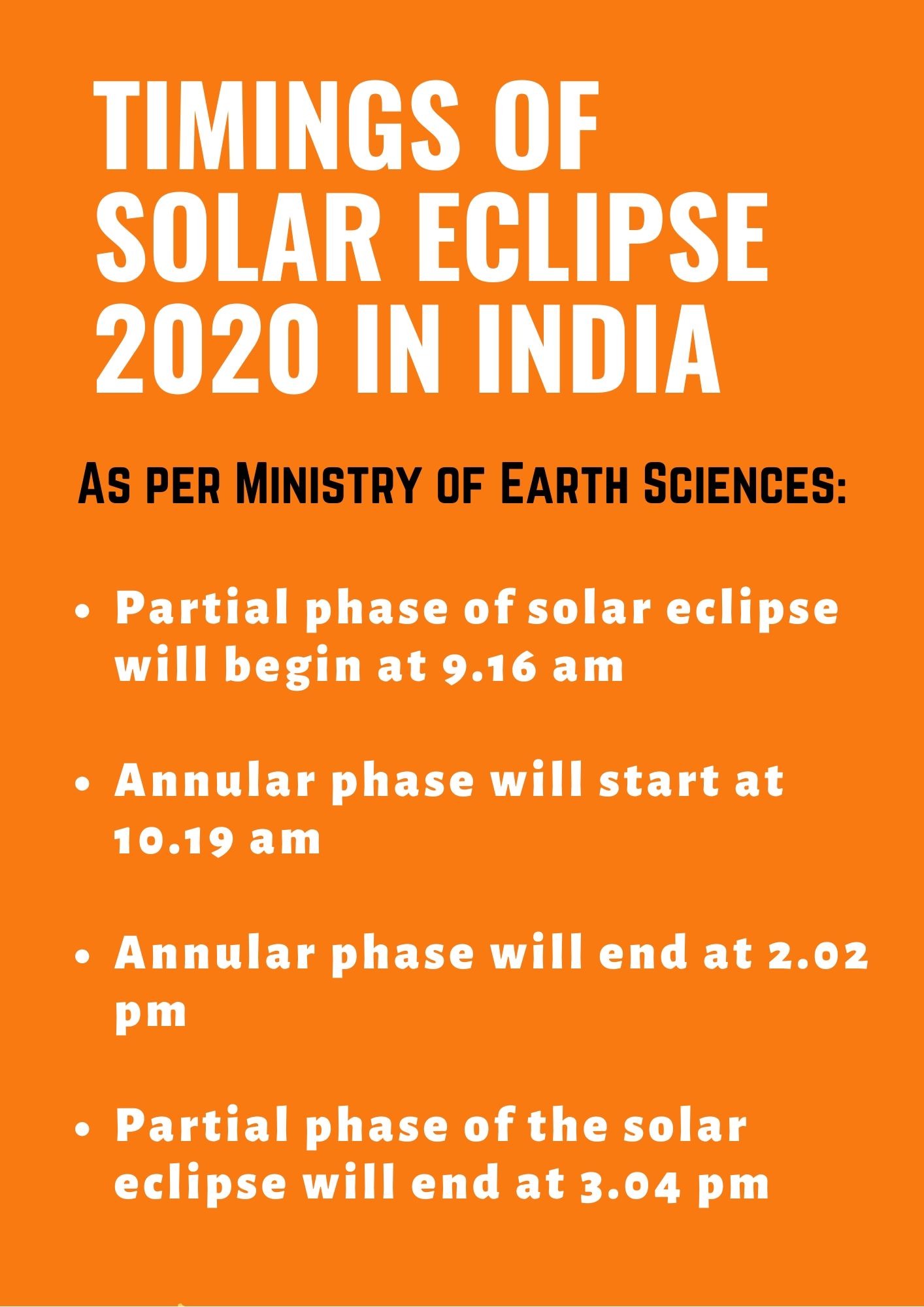Annular solar eclipse observed from Nehru Planetarium in Delhi
Solar Eclipse 2020 LIVE Updates: India witnesses 'ring of fire' today

13:39 June 21
13:34 June 21
Maharashtra: Priests chant mantras at Shirdi Sai Baba temple during solar eclipse
13:26 June 21
Annular solar eclipse observed through telescope in Karnataka's Kalaburagi
13:03 June 21
Pilgrims visit Andhra Pradesh's Srikalahasti temple during solar eclipse
Devotees visited Srikalahasteeswara temple during the annular solar eclipse observed today. Also, special prayers were offered to deities Rahu and Ketu.
12:54 June 21
Maximum visibility of solar eclipse in Uttarakhand, Rajasthan and Haryana, says Scientist
A few regions like Uttarakhand, Rajasthan and Haryana will witness maximum visibility of the solar eclipse, which takes place today.
OP Gupta, the senior engineer of Nehru Planetarium in Delhi, said, "The eclipse will be around 93-94 per cent visible in Delhi. While it is partially visible in other parts of the country, its maximum visibility will be seen in Dehradun, Joshimath, Kurukshetra and Sirsa."
"In Kerala, it is a partial solar eclipse," said Shyam SS, Scientific Officer at Priyadarshini Planetarium, Kerala adding, "Only northern belt will see the full annular eclipse."
It is the first solar eclipse of this year taking place on the summer solstice, which is the longest day in the Northern Hemisphere.
12:50 June 21
West Bengal: Kolkata witnesses annular Solar Eclipse
12:38 June 21
Solar eclipse as observed from Coimbatore, Tamil Nadu
12:36 June 21
Haryana: Solar Eclipse 2020 as seen in the skies of Kurukshetra
12:21 June 21
Devotees visit the Dwarkadheesh temple in Mathura during annular solar eclipse
12:21 June 21
Residents of Gandhinagar observe the solar eclipse through various means
12:12 June 21
Solar eclipse as observed from Amritsar, Punjab
12:11 June 21
Uttar Pradesh: Solar eclipse seen in the skies of Lucknow
12:04 June 21
Annular solar eclipse as observed from Patna's Srikrishna Science Centre
11:04 June 21

Local circumstances relating to certain places in India where the partial phase is visible
11:01 June 21
Solar eclipse as observed from Thiruvananthapuram, Kerala
10:50 June 21
Gujarat: Solar Eclipse 2020 seen in the skies of Gandhinagar
The solar eclipse will be visible until 1:32 PM with maximum visibility of the eclipse at 11:42 IST.
10:46 June 21
Solar eclipse as observed from Dehradun, Uttarakhand
10:27 June 21
Maharashtra: Solar Eclipse 2020 seen in the skies of Mumbai
10:20 June 21

Delhi: Solar Eclipse 2020 as seen in the skies of the national capital today
10:19 June 21
Delhi's Chhatarpur temple to remain open during solar eclipse
Delhi's famous Chhatarpur temple will remain open during the solar eclipse on Sunday.
Several temples across the country have announced that they will remain shut down during the eclipse today.
10:03 June 21
Jammu witnesses Solar Eclipse 2020
The solar eclipse will be visible until 3:04 PM, the maximum eclipse will take place at 12:10 IST.
It will be visible from Asia, Africa, the Pacific, the Indian Ocean, parts of Europe and Australia.
09:18 June 21

Timings of solar eclipse (Surya Grahan) 2020 in India
06:24 June 21
Parts of north India to witness full annular solar eclipse today
New Delhi: An annular solar eclipse, wherein the Sun appears like a ring of fire, will be visible in parts of the country today, the Ministry of Earth Sciences said.
The partial phase of the eclipse will begin at 9.16 am. The annular phase will start at 10.19 am and end at 2.02 pm. The partial phase of the eclipse will end at 3.04 pm, it added.
"Close to noon, for a small belt in north India the eclipse will turn into a beautiful annular (ring-shaped) one since the Moon is not close enough to cover the Sun completely," the Astronomical Society of India said.
The annular phase will be visible in the morning from some places within a narrow corridor of northern India -- parts of Rajasthan, Haryana and Uttarakhand. A few prominent places within this narrow annularity path are Dehradun, Kurukshetra, Chamoli, Joshimath, Sirsa, Suratgarh.
From the rest of the country, it will be visible as partial solar eclipse.
The annular path also passes through Congo, Sudan, Ethiopia, Yemen, Saudi Arabia, Oman, Pakistan, and China.
READ:| All you need to know about 'Ring of Fire' solar eclipse, 2020
The next annular eclipse will be seen from South America in December 2020. Another annular eclipse will occur in 2022, but that it will be hardly visible from India, said N Rathnashree the Director of Nehru Planetarium in Delhi.
A solar eclipse occurs on a new moon day when the Moon comes in between the Earth and the Sun and when all the three celestial objects are aligned.
An annular solar eclipse occurs when the angular diameter of the Moon falls short of that of the Sun such that it cannot cover up the latter completely. As a result, a ring of the Sun's disk remains visible around the Moon. This gives an image of a ring of fire.
Obscuration of the Sun by the Moon at the time of greatest phase of the partial eclipse will be around 94 per cent in Delhi, 80 per cent in Guwahati, 78 per cent in Patna, 75 per cent in Silchar, 66 per cent in Kolkata, 62 per cent in Mumbai, 37 per cent in Bangalore, 34 per cent in Chennai, 28 per cent in Port Blair.
"Places like Delhi will be dark for 5-7 minutes from 11 to 11.30 pm," said Arvind Paranjpye, the Director of the Nehru Planetarium in Mumbai.
"During the eclipse, there are cases when avian creatures assume that it is time to go back to their roosts. However, there has to be more study on the impact of eclipse on birds," he added.
READ:| Astrologer Seemaa Singh explains impact of 2020's first solar eclipse
He cautioned that solar eclipse should not be viewed with the naked eye, even for a very short time as it can cause permanent damage even leading to blindness.
The safe technique to observe the solar eclipse is either by using a proper filter like aluminised mylar, black polymer, welding glass of shade number 14 or by making a projection of the Sun's image on a whiteboard by telescope.
Several organisations have organised lectures on the eclipse and also the virtual viewing of the phenomenon.
Aryabhatta Research Institute of Observational Sciences (ARIES), Nainital, an autonomous institute of the Department of Science & Technology (DST) has organised a special lecture on 'The Science of Solar Eclipses'.
The Nehru Planetarium, Delhi will be webcasting the eclipse, apart from organising discussions, its director Rathnashree said.
Inputs from agencies
13:39 June 21
Annular solar eclipse observed from Nehru Planetarium in Delhi
13:34 June 21
Maharashtra: Priests chant mantras at Shirdi Sai Baba temple during solar eclipse
13:26 June 21
Annular solar eclipse observed through telescope in Karnataka's Kalaburagi
13:03 June 21
Pilgrims visit Andhra Pradesh's Srikalahasti temple during solar eclipse
Devotees visited Srikalahasteeswara temple during the annular solar eclipse observed today. Also, special prayers were offered to deities Rahu and Ketu.
12:54 June 21
Maximum visibility of solar eclipse in Uttarakhand, Rajasthan and Haryana, says Scientist
A few regions like Uttarakhand, Rajasthan and Haryana will witness maximum visibility of the solar eclipse, which takes place today.
OP Gupta, the senior engineer of Nehru Planetarium in Delhi, said, "The eclipse will be around 93-94 per cent visible in Delhi. While it is partially visible in other parts of the country, its maximum visibility will be seen in Dehradun, Joshimath, Kurukshetra and Sirsa."
"In Kerala, it is a partial solar eclipse," said Shyam SS, Scientific Officer at Priyadarshini Planetarium, Kerala adding, "Only northern belt will see the full annular eclipse."
It is the first solar eclipse of this year taking place on the summer solstice, which is the longest day in the Northern Hemisphere.
12:50 June 21
West Bengal: Kolkata witnesses annular Solar Eclipse
12:38 June 21
Solar eclipse as observed from Coimbatore, Tamil Nadu
12:36 June 21
Haryana: Solar Eclipse 2020 as seen in the skies of Kurukshetra
12:21 June 21
Devotees visit the Dwarkadheesh temple in Mathura during annular solar eclipse
12:21 June 21
Residents of Gandhinagar observe the solar eclipse through various means
12:12 June 21
Solar eclipse as observed from Amritsar, Punjab
12:11 June 21
Uttar Pradesh: Solar eclipse seen in the skies of Lucknow
12:04 June 21
Annular solar eclipse as observed from Patna's Srikrishna Science Centre
11:04 June 21

Local circumstances relating to certain places in India where the partial phase is visible
11:01 June 21
Solar eclipse as observed from Thiruvananthapuram, Kerala
10:50 June 21
Gujarat: Solar Eclipse 2020 seen in the skies of Gandhinagar
The solar eclipse will be visible until 1:32 PM with maximum visibility of the eclipse at 11:42 IST.
10:46 June 21
Solar eclipse as observed from Dehradun, Uttarakhand
10:27 June 21
Maharashtra: Solar Eclipse 2020 seen in the skies of Mumbai
10:20 June 21

Delhi: Solar Eclipse 2020 as seen in the skies of the national capital today
10:19 June 21
Delhi's Chhatarpur temple to remain open during solar eclipse
Delhi's famous Chhatarpur temple will remain open during the solar eclipse on Sunday.
Several temples across the country have announced that they will remain shut down during the eclipse today.
10:03 June 21
Jammu witnesses Solar Eclipse 2020
The solar eclipse will be visible until 3:04 PM, the maximum eclipse will take place at 12:10 IST.
It will be visible from Asia, Africa, the Pacific, the Indian Ocean, parts of Europe and Australia.
09:18 June 21

Timings of solar eclipse (Surya Grahan) 2020 in India
06:24 June 21
Parts of north India to witness full annular solar eclipse today
New Delhi: An annular solar eclipse, wherein the Sun appears like a ring of fire, will be visible in parts of the country today, the Ministry of Earth Sciences said.
The partial phase of the eclipse will begin at 9.16 am. The annular phase will start at 10.19 am and end at 2.02 pm. The partial phase of the eclipse will end at 3.04 pm, it added.
"Close to noon, for a small belt in north India the eclipse will turn into a beautiful annular (ring-shaped) one since the Moon is not close enough to cover the Sun completely," the Astronomical Society of India said.
The annular phase will be visible in the morning from some places within a narrow corridor of northern India -- parts of Rajasthan, Haryana and Uttarakhand. A few prominent places within this narrow annularity path are Dehradun, Kurukshetra, Chamoli, Joshimath, Sirsa, Suratgarh.
From the rest of the country, it will be visible as partial solar eclipse.
The annular path also passes through Congo, Sudan, Ethiopia, Yemen, Saudi Arabia, Oman, Pakistan, and China.
READ:| All you need to know about 'Ring of Fire' solar eclipse, 2020
The next annular eclipse will be seen from South America in December 2020. Another annular eclipse will occur in 2022, but that it will be hardly visible from India, said N Rathnashree the Director of Nehru Planetarium in Delhi.
A solar eclipse occurs on a new moon day when the Moon comes in between the Earth and the Sun and when all the three celestial objects are aligned.
An annular solar eclipse occurs when the angular diameter of the Moon falls short of that of the Sun such that it cannot cover up the latter completely. As a result, a ring of the Sun's disk remains visible around the Moon. This gives an image of a ring of fire.
Obscuration of the Sun by the Moon at the time of greatest phase of the partial eclipse will be around 94 per cent in Delhi, 80 per cent in Guwahati, 78 per cent in Patna, 75 per cent in Silchar, 66 per cent in Kolkata, 62 per cent in Mumbai, 37 per cent in Bangalore, 34 per cent in Chennai, 28 per cent in Port Blair.
"Places like Delhi will be dark for 5-7 minutes from 11 to 11.30 pm," said Arvind Paranjpye, the Director of the Nehru Planetarium in Mumbai.
"During the eclipse, there are cases when avian creatures assume that it is time to go back to their roosts. However, there has to be more study on the impact of eclipse on birds," he added.
READ:| Astrologer Seemaa Singh explains impact of 2020's first solar eclipse
He cautioned that solar eclipse should not be viewed with the naked eye, even for a very short time as it can cause permanent damage even leading to blindness.
The safe technique to observe the solar eclipse is either by using a proper filter like aluminised mylar, black polymer, welding glass of shade number 14 or by making a projection of the Sun's image on a whiteboard by telescope.
Several organisations have organised lectures on the eclipse and also the virtual viewing of the phenomenon.
Aryabhatta Research Institute of Observational Sciences (ARIES), Nainital, an autonomous institute of the Department of Science & Technology (DST) has organised a special lecture on 'The Science of Solar Eclipses'.
The Nehru Planetarium, Delhi will be webcasting the eclipse, apart from organising discussions, its director Rathnashree said.
Inputs from agencies


